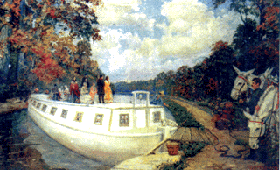
Home | Canal System | Historical Documents | 175th Anniversary
Images | Maps | Tour | Traces | Locks | Boats | Books | Music | Links




NOTE: The year 2020 marked the 20th anniversary of The Erie Canal web site! Hopefully, this site has been both educational and entertaining. The webmaster wishes to thank all those who have helped in this endeavor to present historical information about and images of the Erie Canal, particularly the Canal Society of New York State. Additional information and images from any and all sources will be welcomed. As we face the new decade and continue to enjoy the Erie Canal in both its present state and its historical remnants, you are encouraged to explore the canal and its environs. Enjoy!
On July 4th, 1817, ground was broken for the Erie Canal at Rome, N.Y. Two hundred years later, 2017, is the celebration of the bicentennial of this historic event. Proposed in 1808 and completed in 1825, the canal links the waters of Lake Erie in the west to the Hudson River in the east. An engineering marvel when it was built, some called it the Eighth Wonder of the World.
In order to open the country west of the Appalachian Mountains to settlers and to offer a cheap and safe way to carry produce to a market, the construction of a canal was proposed as early as 1768. However, those early proposals would connect the Hudson River with Lake Ontario near Oswego. It was not until 1808 that the state legislature funded a survey for a canal that would connect to Lake Erie. Finally, on July 4, 1817, the construction of the canal began. In those early days, it was often sarcastically referred to as "Clinton's Big Ditch". However, two years after construction began, the first section of the canal, between Rome and Utica, saw the beginning of commercial traffic. Use of the canal expanded as other sections were completed. When finally completed on October 26, 1825, it was the engineering marvel of its day. It was 363 miles long and included 18 aqueducts to carry the canal over ravines and rivers, and 83 locks, with a rise of 568 feet from the Hudson River to Lake Erie.  It was 4 feet deep and 40 feet wide, and floated boats carrying 30 tons of freight. A ten foot wide towpath was built along the bank of the canal for the horses and/or mules which pulled the boats and their driver, often a young boy (sometimes referred to as a "hoggee", for the commands given to the horses or mules: "Ho" for stop, and "Gee" for go).
It was 4 feet deep and 40 feet wide, and floated boats carrying 30 tons of freight. A ten foot wide towpath was built along the bank of the canal for the horses and/or mules which pulled the boats and their driver, often a young boy (sometimes referred to as a "hoggee", for the commands given to the horses or mules: "Ho" for stop, and "Gee" for go).
In order to keep pace with the growing demands of traffic, the Erie Canal was enlarged between 1836 and 1862. The "Enlarged Erie Canal" was 350.5 miles long, 7 feet deep and 70 feet wide, and could handle boats carrying 240 tons. The number of locks was reduced to 72. Most of the remaining traces of the Old Erie Canal are from the Enlarged Erie Canal era.
In 1903, the State again decided to enlarge the canal by the construction of what was termed the "Barge Canal", consisting of the Erie Canal and the three chief branches of the State system -- the Champlain Canal, the Oswego Canal, and the Cayuga and Seneca Canal. The resulting Erie Barge Canal was completed in 1918, and is 12 to 14 feet deep, 120 to 200 feet wide, and 338 miles long, from Waterford to Tonawanda. 36 Locks were built to handle barges carrying up to 3,000 tons of cargo, with lifts of 6 to 40 feet. This is the Erie Canal which today is utilized more often by recreational boats than cargo-carrying barges.
For a more detailed history of the Erie Canal, see Little Short of Madness.
Particularly interesting portions of the original "Clinton's Ditch" Canal and the Enlarged Erie Canal include:
This web site is devoted to the history of the Erie Canal in general, but focuses to some extent on the middle and western portions of the canal.
The main sections of this site provide views of the old Erie Canal in three ways:
A good introduction to the history of the Erie Canal can be found on the 175th Anniversary Exhibit pages, which originally accompanied an exhibit put together by the Mandeville Gallery of Union College in Schenectady to celebrate the 175th anniversary of the opening of the Erie Canal. More historical information can be found in the Historical Documents section and in the materials listed on the Books and Videos page, or by following the Erie Canal Related Links. Historical and recent maps can be found on the Erie Canal Maps page.
For information about the Erie Canal of today, visit the The Travels of Tug 44 web site, and the Canal Corporation web site.

George Harvey: Pittsford on the Erie Canal, 1837 ...
courtesy: Memorial Art Gallery of the
University of Rochester
http://www.eriecanal.org/index.html